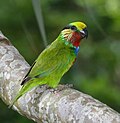| Cyclopsitta | |
|---|---|
 | |
| Double-eyed fig parrot | |
| Scientific classification | |
| Kingdom: | Animalia |
| Phylum: | Chordata |
| Class: | Aves |
| Order: | Psittaciformes |
| Family: | Psittaculidae |
| Tribe: | Cyclopsittini |
| Genus: | Cyclopsitta Reichenbach, 1850 |
| Type species | |
| Psittacula diophthalma [1] | |
| Species | |
Four; see text | |
| Synonyms | |
PsittaculirostrisGray, JE & Gray, GR, 1859 | |
Cyclopsitta is a genus of parrots in the family Psittaculidae. Its four species are native to the island of New Guinea. There are also fig parrots in the genus Nannopsittacus .
The genus contains four species: [2]
| Image | Common name | Scientific name | Distribution |
|---|---|---|---|
 | Double-eyed fig parrot | Cyclopsitta diophthalma | New Guinea and satellites and northeast Australia |
 | Large fig parrot | Cyclopsitta desmarestii | New Guinea and northwest satellites |
 | Edwards's fig parrot | Cyclopsitta edwardsii | lowlands of northeastern New Guinea (Humboldt Bay to Huon Gulf) |
 | Salvadori's fig parrot | Cyclopsitta salvadorii | northwestern New Guinea (eastern shore of Cenderawasih Bay to Cyclops Mountains) |
The genus name Cyclopsitta is a combination of the Greek name of the mythical Cyclops (a race of one-eyed Sicilian giants, whose name is a combination of the Greek word kuklos, meaning "circle" and ōps, meaning "eye"), and the modern Latin psitta, meaning "parrot". [3]